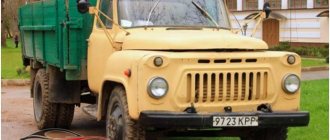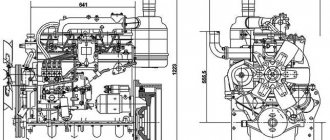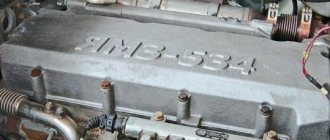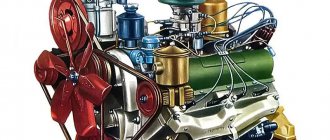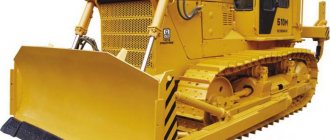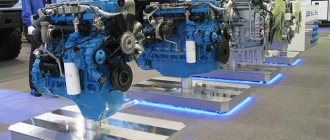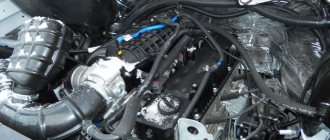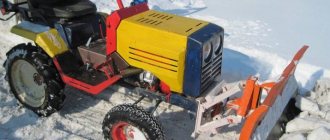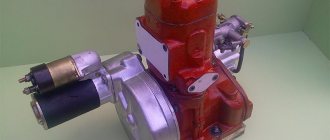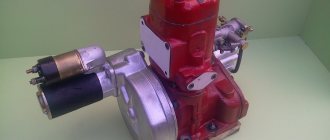The Vladimir Motor Plant produces high-quality diesel engines used for various equipment: tractors, asphalt pavers, road machines, rollers, etc. The four-stroke engine D 144 enjoys deserved popularity among domestic and foreign automakers, thanks to a large number of advantages: it is economical, reliable, and relatively cheap. To restore the performance of this power unit, the car market has a large number of necessary spare parts.
Engine design D 144
Based on this model, three main modifications are produced. The difference between these internal combustion engines is the number of nominal crankshaft revolutions: 1500; 1800; 2000 rpm. In accordance with these values, each motor develops a certain maximum power in the range from 37 to 60 horsepower.
Each of the modifications, depending on the design features and operating conditions, is equipped with the following mechanisms and devices:
- Compressor.
- Automatic stop system.
- Gear type hydraulic pump.
- Electrical network 12V, 24V.
When marking each model, an additional index is added to the basic designation, indicating the features of the configuration.
Basic technical characteristics of D 144
| Cylinder diameter | 105/120 mm |
| Cylinder volume | 4.15 l. |
| Engine weight d 144 | 375 – 390 kg |
| Length | 919 mm |
| Height | 848 mm |
| Width | 741 mm |
Main components and systems included in all D 144 engine models:
- Engine crankcase.
- Connecting rods.
- Cylinders.
- Pistons.
- Crankshaft.
- Electrical equipment, including mounted ones.
- Supply system.
- Gas distribution.
- Cooling.
- Lubricants.
Recommendations for repairs
Engine disassembly is carried out in accordance with the malfunctions that existed before the disassembly itself.
Replacement of piston group parts
Rings are replaced if the fence in the ring lock exceeds 5mm. The grooves for the rings and oil drain holes are cleaned of carbon deposits, and the piston is washed with diesel fuel. The installed rings should move smoothly in the grooves and sink into them.
Pistons are replaced when the height gap between the upper groove and the compression ring is more than 0.5 mm, as well as when the gap between the piston skirt and cylinder exceeds 0.5 mm when the piston is at TDC. When installing the piston, the ring locks are installed at an angle of 90° to one another, but they should not be against the pin hole. In this case, the pistons are installed only in the same cylinders in which they worked.
Replacing HF liners
Inserts must be replaced under the following conditions:
- clearance in connecting rod bearings - 0.4 mm
- clearance in main bearings - 0.35 mm
- neck ovality - 0.15 mm
KV journals, as well as bearings, are made in two denominations. The upper and lower liners are selected by the manufacturer, and failure to complete them is a violation of operation.
When assembling the crankshaft, all oil supply channels in the crankcase and CV must be cleaned, washed with diesel fuel and purged with compressed air. The beds and outer surfaces of the liners are wiped dry, and the shaft journals are covered with a thin layer of engine oil.
The crankshaft should move freely in the tightened bearings, and the lower heads of the connecting rods should move along the journals with hand force.
Description of the crankcase and elements of the cylinder-piston group of the D 144 engine
The diesel engine crankcase is a housing part. It serves as the basis for the placement of working units, components and parts of the internal combustion engine. The design of the base part provides special supports for installing the crankshaft. The upper part of the crankcase is bored out for installation of cylinders.
The cylinders are made of high-strength cast iron. The outer surface of each cylinder is decorated with special ribs that improve cooling. Using special mechanical processing, the inner surface of the cylinders is given a mirror smoothness. If during operation the cylinders are damaged or worn out, they are not subject to boring or other types of restoration. Such elements are replaced with new samples.
When is it necessary to adjust valves on a tractor?
If the tractor engine is not operated continuously, the valves may last for a long time without requiring repairs. To prevent the valve from breaking when it is torn off along the groove, it is necessary to leave pairs of “crackers” intact if the valve device is dismantled. If gears need to be replaced, they must be inserted into the clutch only as indicated by the manufacturer's markings.
A mechanism such as a decompressor is needed, first of all, to make starting a cold engine easier. In addition, a decompressor is needed when sudden braking of a power plant running on diesel fuel is required. This mechanism is a combination of two control pairs: manual and racks, which are connected to the rack using hinges. The levers are fixed to the forks in a rigid manner.
It is worth noting that the adjustment process is not complicated, but if the tractor is used correctly, it does not need to be done often. This is especially true for D-144 valves (diesel engines) - they are easy to operate and do not require complex manipulations during repair.
Attachments and electrical equipment D 144
This system consists of glow plugs, a starter and a generator. As already written above, the voltage in the system can be either 24 or 12 volts. It all depends on the diesel engine model. The power parameters of the working units are shown in the table:
| at 12V | at 24V | |
| Generator power | 700 W | 1000 W |
| Starter power | 6 l. With. | 8 l. With. |
Attachments:
- Belt drives of the generator, cooling system fan, compressor drive.
- Elements of the D 144 engine lubrication system - filler neck, oil dipstick, filter, oil pan.
- Drive of the gas distribution system.
- Fuel filters, fuel injection pump, injectors.
- Manifolds (exhaust, intake).
- Cooling system deflector.
- Fan.
- Starter.
- Generator.
- Flywheel housing.
docking D240 and ZIL boxes
Questions can only be asked after registration.
Please login or register. Hi all! When I bought the 53rd, on the second or third day the release lever burned out! They probably screwed it up before selling it so it wouldn’t growl! and then it all started: I take off the box, and the forks are burned out, I take off the basket, and there’s an ass for the disk. I bought forks, a disc and a releaser, assembled the basket, put everything in it, and then when I stuffed the basket in, I broke off an ear on the steel disk. I went and bought a new basket and started installing it and it won’t fit! I had to modify it a little. Then I put everything together and now I’m suffering; the clutch drives terribly! It’s cold now, I don’t have a garage so I don’t do it! I just want to ask if anyone has encountered this? Why didn’t they install a basket and release lever from the MTZ-80? After all, there is more resource there, and you can lubricate the release lever! and who else knows why the disc fits the splines on the primary zil?
Hi all! When I bought the 53rd, on the second or third day the release lever burned out! They probably screwed it up before selling it so it wouldn’t growl! and then it all started: I take off the box, and the forks are burned out, I take off the basket, and there’s an ass for the disk. I bought forks, a disc and a releaser, assembled the basket, put everything in it, and then when I stuffed the basket in, I broke off an ear on the steel disk. I went and bought a new basket and started installing it and it won’t fit! I had to modify it a little. Then I put everything together and now I’m suffering; the clutch drives terribly! It’s cold now, I don’t have a garage so I don’t do it! I just want to ask if anyone has encountered this? Why didn’t they install a basket and release lever from the MTZ-80? After all, there is more resource there, and you can lubricate the release lever! and who else knows why the disc fits the splines on the primary zil?
Hi all! When I bought the 53rd, on the second or third day the release lever burned out! They probably screwed it up before selling it so it wouldn’t growl! and then it all started: I take off the box, and the forks are burned out, I take off the basket, and there’s an ass for the disk. I bought forks, a disc and a releaser, assembled the basket, put everything in it, and then when I stuffed the basket in, I broke off an ear on the steel disk. I went and bought a new basket and started installing it and it won’t fit! I had to modify it a little. Then I put everything together and now I’m suffering; the clutch drives terribly! It’s cold now, I don’t have a garage so I don’t do it! I just want to ask if anyone has encountered this? Why didn’t they install a basket and release lever from the MTZ-80? After all, there is more resource there, and you can lubricate the release lever! and who else knows why the disc fits the splines on the primary zil?
Go to the topic “operation of a GAZ-3507 dump truck”, there someone installed an imported leaf clutch made specifically for the lawn, it works without any modifications.
Which MTZ?, Which Zil?. The lawn clutch has been tested for decades. What does it mean: it didn’t fit, it was modified? Everything should fit on Gazik. You bought something wrong. As for the adjustment, it’s not difficult either. There you can even visually see how the release disc comes off. You turn the flywheel with the clutch pressed and see where the disc has not been released and adjust that foot.
Source
Features of the gas distribution system of the D 144 engine
In diesel engines of the Vladimir plant, each cylinder has its own head. The head material is aluminum alloy. Thanks to the external cooling fins, as well as the air gap between adjacent housing parts, reliable heat removal from the combustion chambers is ensured. The heads are equipped with intake and exhaust valves. Nozzles and decompression devices are installed in prepared threaded holes. A decompressor is necessary to ensure quick starting of a diesel engine at low ambient temperatures.
Methods for providing thermal clearance
With an overhead design, the camshaft acts on the valve stem either directly or through a rocker arm. The use of a rocker makes it possible to reduce the difference in the camshaft profile relative to the maximum valve movement when opening. When the camshaft directly impacts the valve stem, the stem experiences significant lateral force, which leads to increased wear. To avoid this, the end of the rod is covered with a special glass, which takes on the lateral force, moving in its own guide seat, and transmits the axial force to the valve. Adjusting washers are installed between the cup and the camshaft cam. If the design has rocker arms, then special adjusting screws with locknuts are installed on them.
Read more: A place in the people's garage
Many modern engines, especially those with more than two valves per cylinder, are equipped with hydraulic valve lash adjusters. In these designs, adjustment of thermal gaps is not required.
Engine lubrication system D 144
The lubrication system of the D 144 engine family is of a mixed type. Here, engine oil is supplied to the rubbing surfaces of working units and parts by force under pressure and by splashing. In addition to its lubricating function, the oil performs effective heat removal. To create the required pressure in the system, a pump with a gear block is used. The system has a built-in special valve (reducing valve), which is designed to control the pressure of the lubricating fluid.
The reliability of the internal combustion engine and the vehicle as a whole depends on the quality of functioning of the lubrication system. To ensure stable operation of the diesel engine, the following measures must be taken:
- Check the engine oil level regularly;
- compensate for the missing amount.
When performing engine maintenance, lubricating fluid and oil filters are replaced. The oil radiator is also regularly maintained. The range of maintenance work for the D 144 engine includes items for adjusting valve clearances and the fuel supply advance angle.
Valve settings
During operation, the valves increase in length by tenths of a millimeter. This seemingly insignificant expansion requires compensation, for which a gap is required between the end of the valve stem and the rocker arm. Adjustment of the valves of the T 40 tractor is ensured by a special adjusting screw. When screwing it in, the valve lever arm rises and the gap decreases; when unscrewing, the opposite is true. It must be taken into account that the gap at the inlet should be smaller than at the outlet, since the latter heats up more.
The gap size is checked with a special probe. It should be 0.3 mm. The check is carried out only on a cold engine. In addition to adjusting the gaps, timing maintenance includes checking the tight fit of the valves to the seats and the presence of lubricant, as well as the wear of seals, bushings, etc.
Cooling system D 144
In order for the technical characteristics of the D 144 engine to be maintained for a long time, it is necessary to provide reliable high-quality cooling, regardless of the time of year and other external operating conditions. The lion's share of heat removal work is performed by an axial fan.
Directed air flows pass through the gaps and ribs of hot parts and components of an internal combustion engine. Using a special casing and deflectors installed between the working cylinders, air moves freely in a given direction. To control the intensity of air flows, a special rotary disk is installed in the air intake.
Tractor T-40
The T-40 tractor model was produced at the Lipetsk plant from 1961 to 1995. In total, more than 1 million different modifications of the T-40 rolled off the assembly line. Based on this device, a whole line of tractors was developed. Subsequently, the technical characteristics of this machine were used in the design of the LTZ.
Brand history
At the end of World War II, the Lipetsk plant began producing tracked tractors, since many rural residents urgently needed this equipment to restore their farms. However, time passed, and tractors on tracks were no longer satisfied with their technical characteristics and speed of work. There was greater demand for wheeled versions.
Due to its wide range of operation and reliability of structural components, the T-40 tractor model is still in demand.
In 1958, the company completely abandoned the production of tracked vehicles and headed for wheeled models. The first serial production model was released in 1960.
The T-40 tractor is used in agriculture, road, utility and construction enterprises.
Almost immediately, development and testing of a more powerful type of T-40 began. During the design of this model, the shortcomings of previous machines were taken into account. People appreciated the capabilities of the T-40 and began to buy it directly from the assembly line, thanks to this the company was provided with orders for many years. Until the end of production, the T-40 Tractor was in great demand among buyers.
Adviсe
Take a few tips from experienced drivers:
- if a diesel engine starts in cold weather, you need to turn on the high beam headlights for a few minutes, then press the clutch for a few seconds, and then give the starter a rest, this can help the diesel engine start;
- You can add kerosene to the fuel; even during long-term operation at sub-zero temperatures, this composition does not affect the operation of the entire diesel engine structure;
- use additives that reduce the thickening point of diesel fuel;
- To quickly warm up frozen diesel, you can put a cover on the car and place a heat gun under the bottom. The temperature under the engine must be brought to at least zero degrees;
- if we start a diesel engine in cold weather, then for a quick start you can spray ether into the air intake; you should try to start the engine while the ether is in a sprayed state;
- another method proven over the years by experienced drivers of diesel cars. If the car does not want to start in the cold, you need to warm up the drain manifold. This can be done simply, using a piece of paper and matches. The paper is set on fire and the collector is heated with the help of smoke, in this case the car starts up very quickly;
- You need to buy diesel fuel only at proven gas stations; saving on diesel fuel can cost you a lot on repairs.
Search
how to take
ignition on a 4t scooter? How it works, Error and settings How to install the ignition
on a 4t scooter? A 4-stroke engine may seem difficult to start for a variety of reasons, but they all lead to the same result. the engine stops. But the lack of a timely spark may not be the only condition that the engine will not start. To see for sure that ignition is a prerequisite for engine malfunction, it is necessary to check all other possible faults that could interfere with engine operation and eliminate them. The ignition system may show a malfunction, either mechanical or electrical. Using common techniques, you can determine whether it is a mechanical fault or an electronic component to blame. At home, you can repair any damage to your 4-stroke scooter's ignition system.
Causes of malfunction of a 4-stroke scooter
If the scooter engine does not start, the prerequisites can be very different: 1. You must say “how to install the ignition on a VAZ-2106.” This is a fairly common question. There is no fuel in the combustion chamber. 2. Air supply is not adjustable. 3. No compression occurs. Burnt and deformed valves do not provide compression. A prerequisite for non-compression may be incorrect assembly of the piston group and failure of the cylinder itself. 4. Faulty gas distribution mechanism responsible for the operation of the valve. 5. Faulty spark plug. 6. Ignition spark is not generated during mechanical operation of the generator.
